Want to make sure every team member knows their part and how it fits into the whole project?
Need to avoid inter-departmental chaos, delivery bottlenecks, and dreaded delays?
Hold on to your seats because we’re about to unveil the hero of project management.
Spiderman? Close, but no—it’s dependency mapping! This tool will make it easier for any project manager to create a complex web of processes that rely on each other for consistent outcomes.
In this guide, we’ll look at:
- The role of dependency mapping in project management
- Steps and best practices for successful dependency mapping
- Mapping dependencies in an Agile project environment
Buckle up, for it’s going to be one epic adventure! 🎢
- What is Dependency Mapping?
- How to Use Dependency Mapping to Improve Project Planning: Step-by-Step Process
- Step 1: List all the tasks and subtasks to be completed
- Step 2: Connect tasks and responsibilities to relevant stakeholders
- Step 3: Identify dependencies—internal and external
- Step 4: Organize dependencies based on their types
- Step 5: Consider constraints
- Step 6: Create a map plotting dependencies and constraints
- Best Practices for Successful Dependency Mapping
- Navigating Dependencies in Agile Teams
- Excel at Dependency Mapping with ClickUp
What is Dependency Mapping?
Dependency mapping is a highly visual process that helps identify and illustrate relationships between different tasks and resources in a project. The idea is to provide project managers and stakeholders with a flowchart- or network-style insight into:
- Tasks and deliverables in a workflow
- Links and patterns between processes and delivery points
- Resource requirements and distribution
Think of a dependency map as a tool to dodge those traffic jams and hold-ups that can happen when one task relies on the outcome of another. Once the sequence is established, managers can get a grip on the project timeline and resource allocation. More analytical teams would use it for critical path analysis, which allows for exploring flexible schedules.
Skip the dependency map, and you’re possibly inviting messy operations, scattered project data, and serious communication hiccups. You’d have to spend hours identifying and fixing these issues. Creating a project dependency map is a proactive measure to predetermine these issues and plan the interplay between workflow components accordingly. 💡
Tangible benefits of dependency mapping
Dependency mapping has a lot of holistic perks that can improve how everything works in your projects. Let’s break down four notable benefits:
- Better project scheduling: Because dependency mapping allows you to comprehend the connections between tasks, you can arrange work in a logical order and assign resources more effectively. This leads to reliable time and cost estimates, which are crucial for maintaining project budgets and schedules, especially in a volatile environment
- Reduced downtime risk: When dependencies within a project are graphically represented, it becomes simple to identify tasks that, if not completed on time, could cause delays. This proactive strategy helps your team handle potential issues before they turn into bigger challenges, saving both time and money
- Improved team communication: With an easy-to-understand graphical representation of project tasks and dependencies, stakeholders can easily grasp their roles and responsibilities. This clarity enhances teamwork, minimizes context switching, and guarantees that everyone is striving for the same objectives
- Faster strategic decision-making: Project managers can step up their game by understanding delivery interconnections, which helps them prioritize tasks, manage resources, and assign duties based on predicted big-picture impact. This also paves the path for straightforward project tracking and faster response time to roadblocks
How to Use Dependency Mapping to Improve Project Planning: Step-by-Step Process
When it comes to dependency mapping, a one-size-fits-all approach won’t work. The strategy changes depending on the particulars of your project, employees, and external collaborators. But, you can follow some standard steps to create comprehensive and easy-to-follow dependency maps.
It’s important to clarify your digital tools for the mapping process. Some popular enablers in this field include Gantt Charts, network diagrams, flowcharts, and mind maps. ClickUp is one project management solution with various diagramming features and templates to cover all your dependency mapping needs. 🔥
Let’s walk you through the general dependency mapping steps and set you up with some options within ClickUp that can assist you!
Step 1: List all the tasks and subtasks to be completed
Alright, first things first—once you’re ready to begin with mapping project dependencies, start by making a good old list of everything you need to get done. We’re discussing covering all the tasks that take you from Point A to Point B.
Once you’ve got this list down, you’ll have a tangible roadmap to determine what depends on what in the later steps. Simple, right? So, grab your pen and paper and start jotting down what’s on your master to-do list.
Oh, wait! You don’t need a pen and paper if you’re familiar with the ClickUp Task Management Suite. If you’re not, listen up! 📢
This suite is designed to help you create a cohesive and accessible network of project tasks. In the case of dependency mapping, you can:
- Set up tasks or break them down into bite-sized subtasks
- Customize due dates to have an estimate of completion times
- Identify what tasks can be automated to facilitate efficiency (they can be automated with ClickUp Automations down the line)
- Put on task tags for easy identification
You can give your master list a makeover with ClickApps, which allows for intricate customization of workflows.
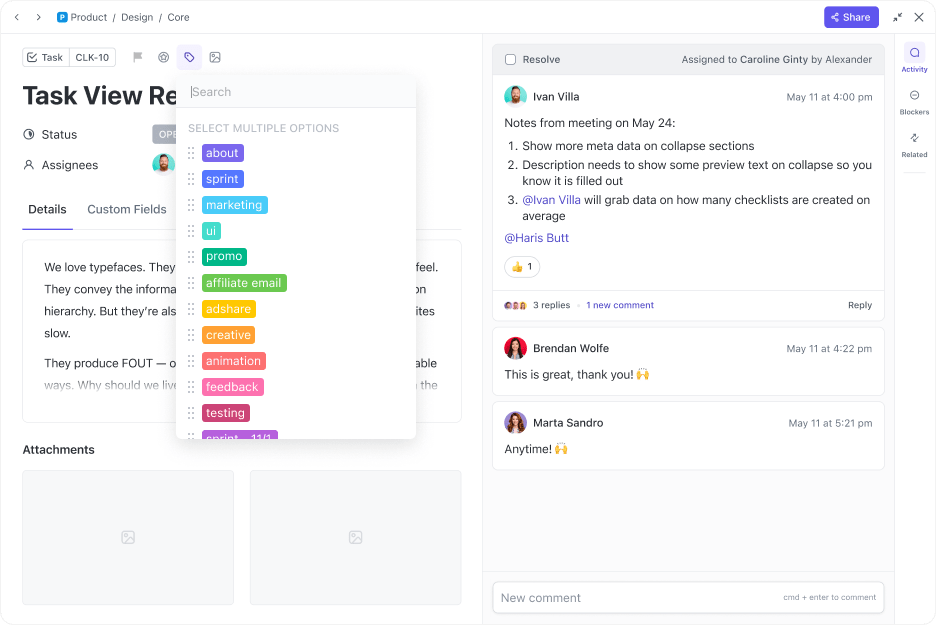
Here’s a tip: Don’t go solo on this! Get as many brains in the game as possible. The more, the merrier! Round up folks from different teams because, let’s be real, they each bring a unique perspective to the table. This way, you can register minor or specialist tasks that might otherwise slip through the cracks.
Step 2: Connect tasks and responsibilities to relevant stakeholders
After you have your task list, assign each task and subtask to stakeholders. This process ensures everyone has a transparent overview of their roles and responsibilities, leading to better coordination and efficiency.
You’ve got options galore for managing task assignments in ClickUp. For instance, those mapping out complex dependencies would love to jump on ClickUp Whiteboards to get a visual representation of tasks alongside one or more assignees. The canvas has built-in connectors, sticky notes, and other tools to confidently ideate task assignment workflows.
Don’t want to start from scratch? The ClickUp SwimLane Flowchart Template gives you a readymade map to identify the flow of team roles and track cross-collaborative task flows. Furthermore, you can create specific user groups to view tasks by Teams within a Workspace.
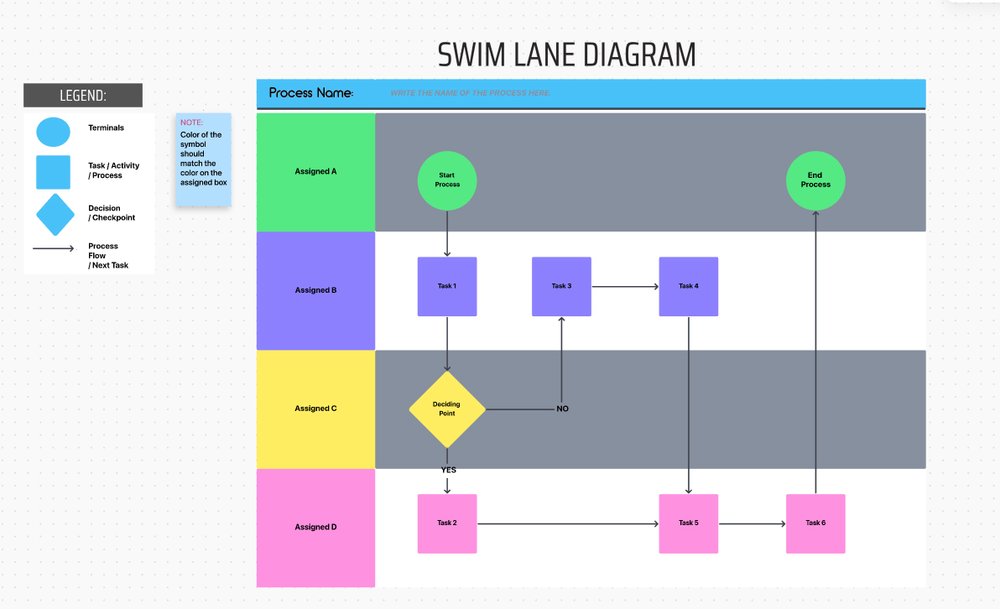
Step 3: Identify dependencies—internal and external
Now, let’s move on to the fun part: uncovering the connections between tasks. You have two types of dependencies to look for:
- If one task’s completion leans on another’s progress within the company—that’s an internal dependency
- Some tasks may hinge on something happening outside the company—that’s an external dependency
Let’s say you’re working on a software development project. The coding work, Task A, depends on completing the requirements gathering, Task B, to be completed by the analysis team. This internal dependency ensures a logical sequence of tasks within the project team.
In the same software development project, an external dependency arises when you need a specialized software tool from an external vendor for the testing phase. Since you can’t control the vendor’s timeline, it’s vital to coordinate and communicate effectively to manage this dependency to prevent any delays in your project schedule.
Once you know what each task is leaning on, sort out if they’re inside the company or playing in the external field in a detailed log.
But why just write them down when you can put them to work?
With ClickUp’s Task Dependencies tool, you can set up three types of connections for a task:
- Waiting on: List all the tasks that need to wrap up before diving into this one
- Blocking: Highlight tasks that can’t kick off until this task wraps up
- Link to: Connect tasks that are related but not overly dependent
To access this feature, click the ellipses menu in your app, open the action tray, and add tasks as dependencies. With Relationships in ClickUp 3.0, you can also enable task dependency warnings for quick rescheduling!
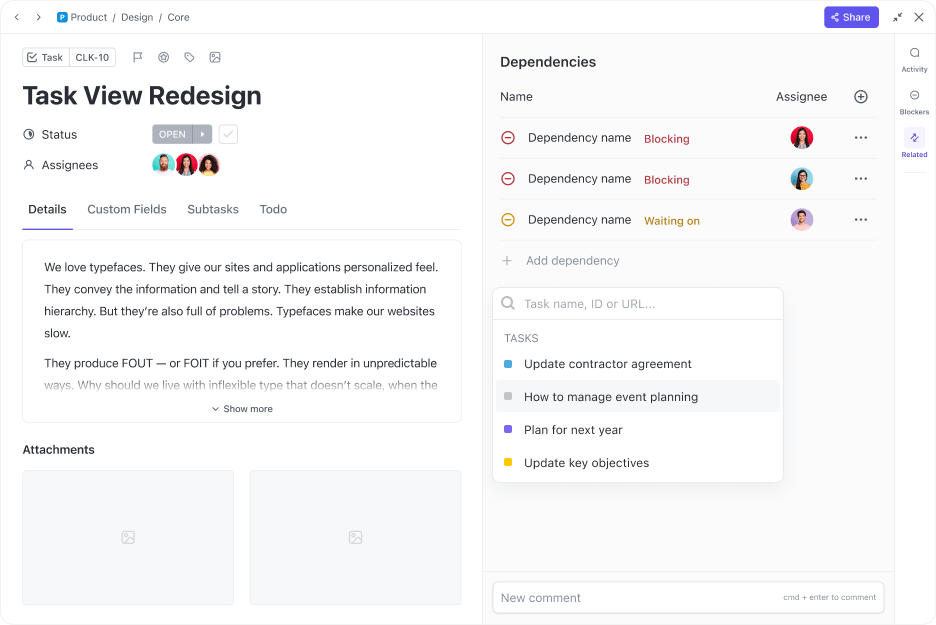
Step 4: Organize dependencies based on their types
Task relationships are like a dance, but with tasks—and need to be organized!
In this step, we’re primarily categorizing dependencies as downstream or upstream, meaning the progress of one task influences another either further down the line or back up the chain. Picture it as a tag team: Task A has a say in Task B’s progress downstream, and vice versa.
Plus, you’ve got to pinpoint how the two tasks are related. The common practice is to classify tasks into tidy little groups, such as:
- Finish to start (FS): Task A wraps up before Task B gets the green light 🚦
- Finish to finish (FF): Task B is in the finish line queue, waiting for Task A to cross it
- Start to start (SS): Task B can’t kick off until Task A does
- Start to finish (SF): Task A’s completion depends on Task B getting started

You can show simple dependencies using most spreadsheet tools, but they support limited scalability and layouts. ClickUp offers multiple layouts, such as the Gantt Chart, List, Board, or Calendar view, to get different perspectives into task relationships at any scale. Use Custom Fields to highlight the relationship type, such as FF or FS, while plotting complex workflows.
Step 5: Consider constraints
It’s time to zoom in on a critical part of your project—figuring out delivery limitations and risks. It’s like spotlighting the dark corners where potential project monsters might lurk. This is the prime time to bring those worries into the open and create solid backup plans. ⚠️
In general, there are six main project constraints that need your attention while dependency mapping:
- Scope: Are your team members, clients, and stakeholders aligned on the project’s scope? Make sure to keep the scope of work document updated and accessible
- Cost: Steer clear of unexpected financial bumps by outlining your payables and receivables. Jump on the ClickUp Budgeted Project Management Template if you need help!
- Time: A time constraint can be anything that messes with your project’s progress and leads to missed deadlines
- Quality: You need to make choices about what compromises you’re willing to make in terms of project quality to speed up the project or cut costs
- Resources: Make use of resource allocation tools to manage time and team effort effectively
- Risk: Identify the delivery risks within your project and explore contingency plans
Recognizing constraints along with dependencies ensures that the final schedule you create is realistic and immune to most setbacks. Before you move to the final step, consider laying out the dependency details and constraints for everyone in a meeting and invite feedback. You can use the ClickUp Project Kick Off Meeting Template to present your findings to project stakeholders.

📮 ClickUp Insight: 64% of employees occasionally or frequently work outside their scheduled hours, with 24% logging extra hours most days! That’s not flexibility—that’s never-ending work. 😵💫
ClickUp Tasks help you break big goals into smaller, manageable steps, so you always know what to tackle next—without the overwhelm. Just ask ClickUp’s AI to generate subtasks, add checklists, and map dependencies to stay organized and in control. Meanwhile, ClickUp Automations streamline routine work by handling updates, assignments, and reminders—so you can spend less time on busy work and more time on what matters. 🚀
💫 Real Results: Pigment improved team communication efficiency by 20% with ClickUp—keeping teams better connected and aligned.
Step 6: Create a map plotting dependencies and constraints
Now, it’s time for the grand finale! Take all the information you’ve gathered in the earlier stages and weave it into a map. The entire project, every task, and the intricate dance of dependencies are all laid out before your eyes.
Dependency mapping is a breeze with ClickUp’s versatile diagramming options. For example, the platform’s rich Gantt chart view is ideal for creating project timelines with adjustable dependencies. And, with ClickUp Mind Maps, you get a drag-and-drop interface to establish a crystal-clear order of operations, ensuring everyone is on the same page about task sequences.
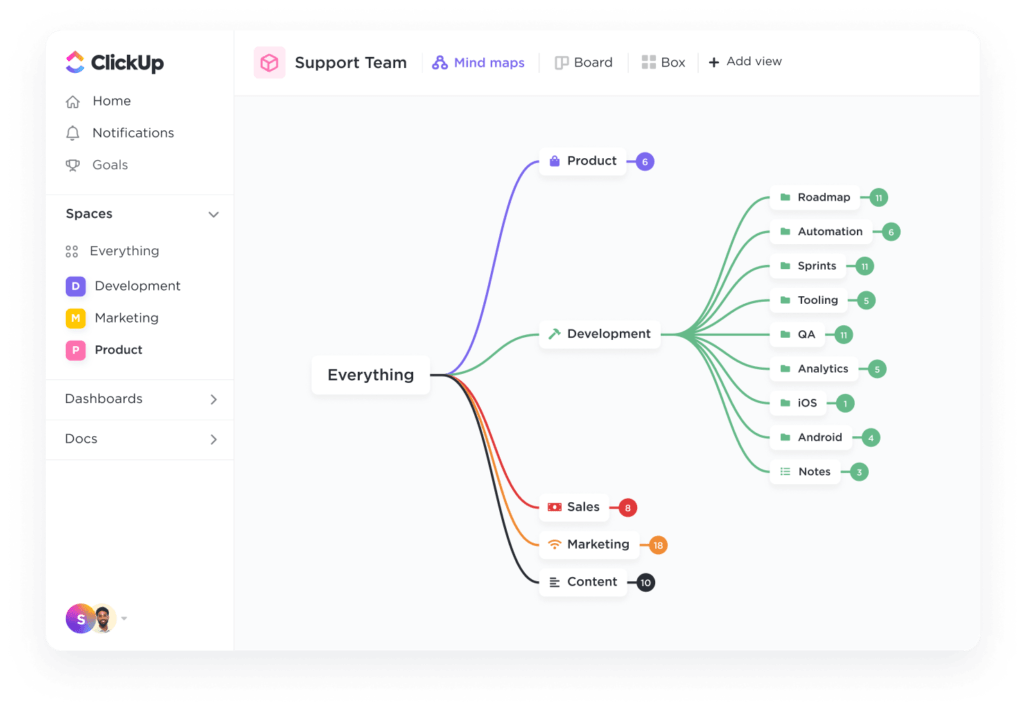
The exciting part is that it’s also possible to link multiple departments or clients to particular tasks or orders by extending dependencies to other Workspaces.
Yes, you read it right—the same dependency mapping system works seamlessly for those in programming, marketing, HR, customer service, and beyond. In this shared space, everyone can see how their work fits into the bigger picture, creating a sense of unity and shared purpose.
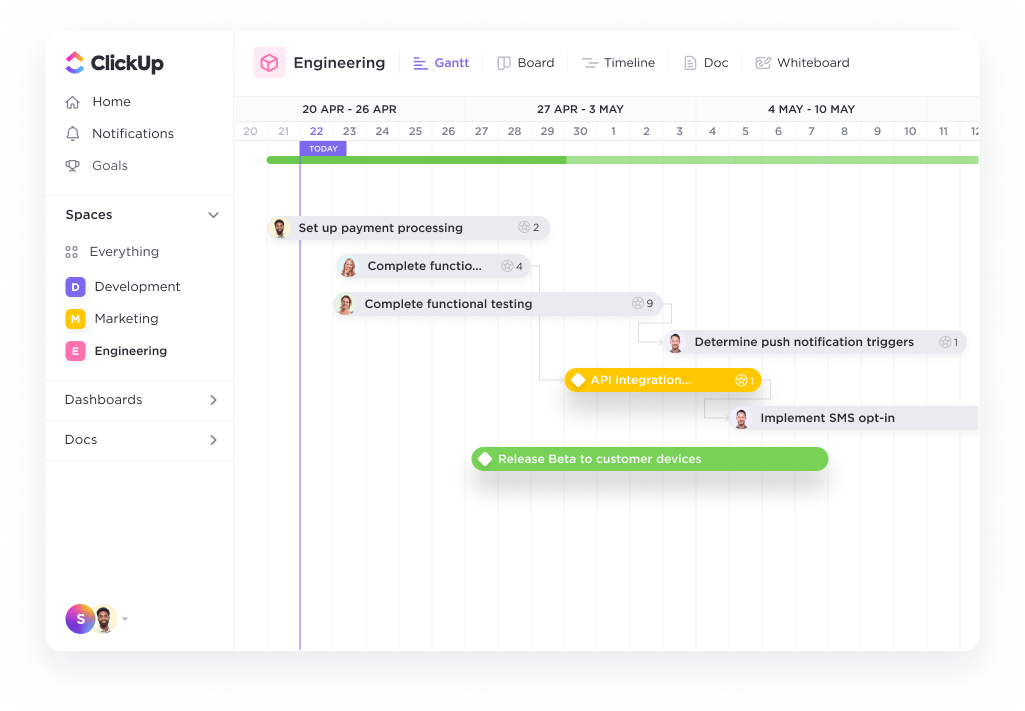
To get a head start on your planning work, tap into the convenience of the readymade ClickUp Dependency Mapping Template. It offers a granular view of project components and helps streamline plotting tasks!
So, ready, set, map! 🗺️
Best Practices for Successful Dependency Mapping
Now that you’ve got the basics of dependency mapping down, here are some tips to maximize its effectiveness.
1. Ensure a unified understanding
Before diving into dependency mapping, ensure everyone is on the same page. It’s not just about clarifying the project’s scope—you should also pay attention to adding clear labels and symbols to your dependency chart to boost understanding.
2. Leverage color coding to explain dependencies
Whether you’re using a virtual whiteboard or a flowchart for mapping, you may want to use the color coding options within the tool to define the strength of the relationship. For instance, you can use unique colors to denote strong, weak, or optional dependencies.
3. Maintain timely updates
Dependency maps are not static blueprints. You must keep them alive and relevant by adding new tasks and dependencies as they emerge. At the same time, archive items that are no longer relevant. ClickUp enables real-time updates and notifications that make it easier to update project stakeholders on these changes.
4. Integrate into planning
Beyond tracking dependencies, use your maps for simultaneous task and capacity planning. This doesn’t have to be a massive company-wide effort involving large meetings. Just pick a core team to analyze dependencies and keep the efforts concentrated during the planning phase.
Navigating Dependencies in Agile Teams
The ideal Agile workflow setup envisions entirely self-sufficient, cross-functional teams that deliver value seamlessly from start to finish, free from external dependencies. However, in reality, complete independence isn’t always achievable. Collaboration is inherent in an agile environment and requires an understanding of dependencies across systems, processes, and teams.
Still, managers and Scrum leaders should distinguish between different types of dependencies. Some arise purely due to poor organizational design or unnecessary complexity, and agile teams should strive to eliminate these. On the other hand, certain dependencies are essential for effective collaboration, delivery, risk management, or even technical reasons.

The ultimate goal for agile organizations is not to eradicate all dependencies but to organize them into cross-functional teams. There should be an effort to structure teams in a way that minimizes unnecessary dependencies, fostering independence within each team.
Similarly, agile teams must focus on continuous improvement and regularly hold sessions to identify and eliminate avoidable dependencies.
Excel at Dependency Mapping with ClickUp
Dependency mapping helps you navigate your project’s complex network of dependencies, bending them to your advantage.
Linking multiple tasks together is possible with ClickUp’s capacity planning and resource scheduling tools. You can run multiple tasks simultaneously by linking them to the same predecessor, making even the most complex workflows super efficient. Creating, reviewing, and managing—everything’s manageable from a single platform!
This project management software also helps you check out possible risks, do some number crunching, and plan your work smarter. So, sign up for ClickUp today—it’s free and a must-have for project managers! 🙌



